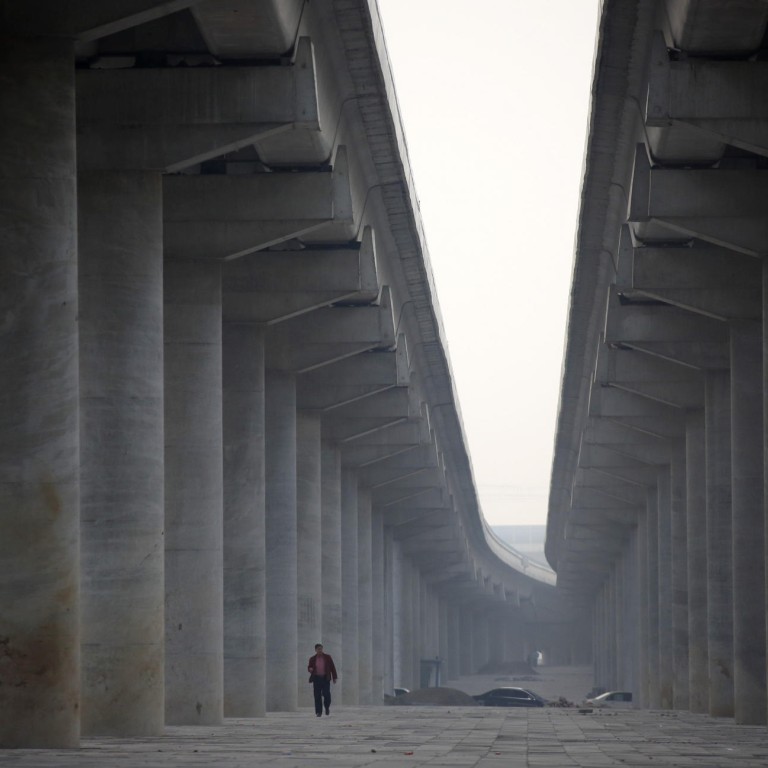
China's credit-driven train runs out of track
Far from solving the cash crunch, Beijing's loose monetary policy will further drive up bad debts
A financial drama is unfolding on the mainland as the new year begins. Last week, for the second time in six months, interest rates in the interbank market surged above 10 per cent, sparking fears of a liquidity crisis that would trigger mass defaults.
Western investors largely ignored the cash crunch and failed to grasp its potential significance. Although the situation has largely eased after the People's Bank of China injected at least US$55 billion into the market, that isn't the end of the story. These repeated crises are a sign that the foundations of the mainland's investment-driven growth model are crumbling, with unsettling implications for the rest of the world.
To those who wrote off the mainland's first banking seizure in June as a fluke, this latest episode appeared to come out of nowhere. They cast about for explanations: perhaps some seasonal surge in cash withdrawals was to blame, or the US Federal Reserve's decision to taper its bond-buying policy. Optimists assumed the PBOC was tightening credit on purpose, as a warning to banks to rein in unsafe lending practices. With inflation at manageable levels, they reasoned, the central bank had plenty of room to loosen monetary policy again and ease the cash crunch.
Rein in credit growth, even modestly, and there isn’t enough to go around
In fact, loose monetary policy is the problem, not the solution. Two simple words - bad debt - are the key to understanding why the mainland has too much money, yet not enough. In the years since the global financial crisis, it has racked up impressive growth in gross domestic product by engineering an investment boom, fuelled by a surge in easy credit. Total debt has risen from 125 per cent of GDP in 2008 to 215 per cent in 2012. Credit has spiralled to US$24 trillion from US$9 trillion at the end of 2008.
A lot of that money has gone into projects whose purpose was to inflate the mainland's economic statistics, not to generate a return. Officially, its banks report a non-performing loan ratio of less than 1 per cent. In reality, they are rolling over huge amounts of bad debt, both on their own books and by repackaging it into retail investment products - many of them extremely short-term - that promise ever-higher rates of return.
While banks can hide bad debt by playing this shell game, it doesn't change the fact that they're not getting their money back. With their capital locked up in existing projects, the only way they can finance the next round of big investments - and keep mainland GDP growth rates from collapsing - is by expanding credit. More and more of that new credit is now eaten up paying imaginary returns on the growing pile of bad debt.
Last year, total credit on the mainland grew about 20 per cent from an extremely high base. Yet the cash needs of its banks aren't what they seem. In addition to its declared balance sheet, each bank is juggling a host of dubious assets and hidden cash obligations on what amounts to a "shadow" balance sheet. Rein in credit growth, even modestly, and there isn't enough to go around.
That's what authorities discovered in June, and again last week. In both instances, the PBOC didn't take away the punch bowl by tightening credit, it merely tried to resist handing over an even bigger punch bowl. The result, both times, was a near-meltdown in the interbank market that threatened to unleash a cascade of defaults throughout the economy. Nor have the signs of financial stress been limited to the interbank market: over the past few months, bond yields have steadily increased, even as the economy slows.
The PBOC could, and did, halt the crisis by injecting more cash. But in doing so, it effectively cedes control over monetary policy to the shadow banks. Runaway lending continues, bad debts mount even higher and the need for more cash becomes that much more acute. Far from solving the problem, pumping in more cash just kicks the can further down a dead-end street.
The leadership clearly recognises the economy needs to move in a new direction. But the first crucial step, weaning the mainland away from its addiction to debt-fuelled stimulus, is proving a lot harder than many imagined. The leaders are riding a runaway train that they don't quite know how to stop. And they're running out of track.
